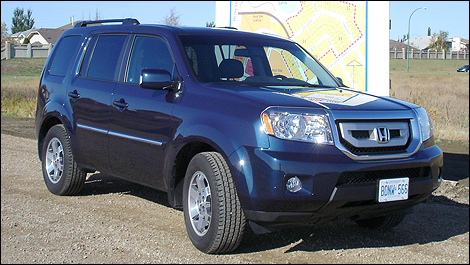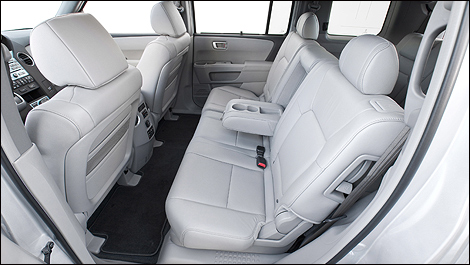

Design
The family van from Honda seems to have grown somewhat. At least is sure feels that way when you have seating for up to eight and some luggage space left over. That's only on the inside. When you look at the outside, there are wheel flares that broaden front end and if you walk around to the front there is a grille that is dominated by the Honda "H". Headlights blend in with the rest of the front and below the main grille there is an opening in the front fascia that takes more air into the front.
Along the sides there is a narrow impact strip to keep other doors out of your sheet metal. Basically it runs the distance between the wheel arches just like the tow generously cut doors do. Officially, the Pilot is a Cross-Over Utility Vehicle so it makes use of conventional doors front and back. At the rear is a very large and well-balanced rear hatch that on the touring model is power actuated.
Unibody Frame
One of the unique items on the Pilot is something you will never see. Honda designed what is best called a unibody frame. Normally a unibody doesn't have an identifiable frame. If you looked a stripped Pilot and then follow the boxed in sections, it would look exactly like a frame. The only difference is that the gaps between parts of the frame are filled in to technically make it a unibody.
The quality of the frame is important because it sets the tone for how well the vehicle will handle and stop. Springs and shocks can be calibrated better and the steering gear can be set in with better geometry. The list goes on and you can rest assured that Honda did it right. Ride quality is excellent.
Ride and Handling
Ride quality is also firm with more of an emphasis on positive ride characteristics rather than the soft floaty feel of many vans. The suspension on the Pilot consists of MacPherson struts up front and a multi-link rear system with trailing arms, shocks and coil springs. Honda's power steering provides good road feedback. The Pilot goes where you want it to, when you want it to. Part of that can be traced back to the low profile tires which have very little side wall wind up, but the majority of the credit goes to the steering.
No comments:
Post a Comment